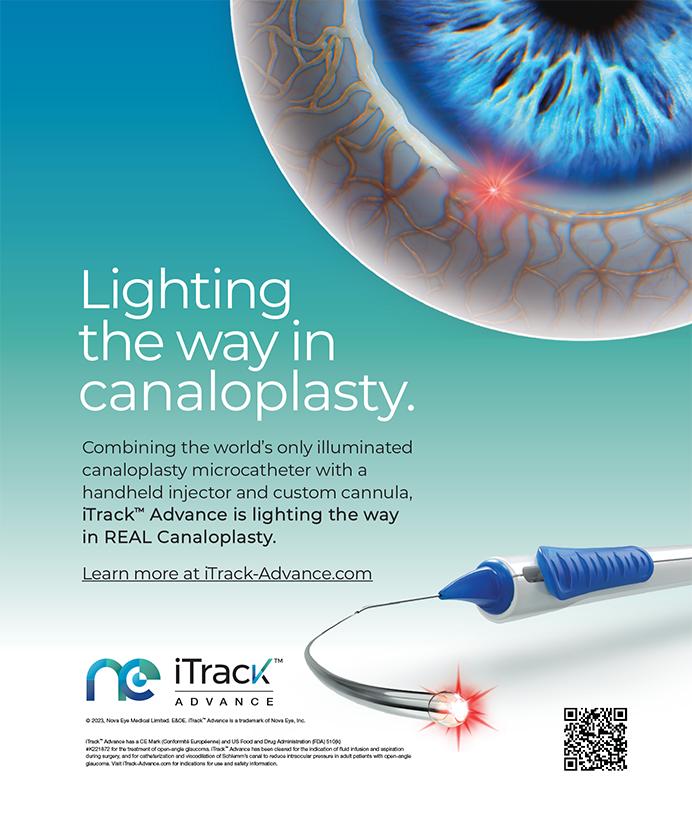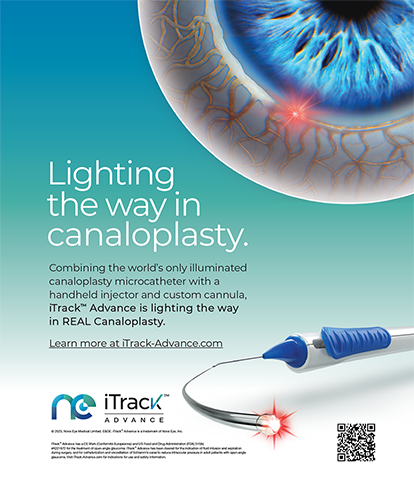Of the three currently available presbyopia-correcting IOLs available in the United States, I use the AcrySof Restor Aspheric IOL (Alcon Laboratories, Inc., Fort Worth, TX) for the majority of my patients for a number of reasons. Most significantly, this IOL almost guarantees spectacle-free near vision combined with very good distance vision. None of the current presbyopia-correcting IOLs, however, is perfect for every patient. One of the most common complaints with the AcrySof Restor IOL (Alcon Laboratories, Inc.) is of sunbursts and glare. Although the incidence of this unwanted visual phenomenon is infrequent,1 it can be bothersome when it occurs. This article examines the problem and suggests how to address it.
CASE No. 1
Presentation
A 74-year-old female (Figure 1) with significant bilateral cataracts complained of difficulty driving at night. Her preoperative manifest refraction was 4.50 -0.50 X90 = 20/50 OD and 6.00 -0.50 X90 = 20/60 OS. Her keratometry (K) readings were 42.50/42.25 OD and 42.50/42.00 OS. Her preoperative pupils measured 5 mm in dim light and 3 mm in bright light.
The patient underwent uncomplicated phaco surgery with the implantation of the AcrySof Restor lens (the aspheric model was not available at the time of her surgery) in her nondominant right eye. On the first postoperative day, her UCVA was 20/40 distance and J1 near. The IOL was well centered, and the patient was happy with her outcome.
She returned for her 1-week postoperative visit with complaints of sunbursts and glare that were especially noticeable at nighttime. Her UCVA was 20/30 and J1 . A manifest refraction did not yield any subjective improvement in her vision or symptoms. Corneal topography was normal, and the postoperative K readings were similar to the preoperative values. I started the patient on a trial of brimonidine tartrate 0.5 (Alphagan; Allergan, Inc., Irvine, CA) in hopes that the mild pupillary constriction would improve her symptoms.
On her 3-week postoperative visit, the patient's UCVA remained 20/30 and J1 , and she was still symptomatic and unhappy. Her BCVA was 20/25 with a manifest refraction of 0.25 -0.75 X107. The patient required the removal of the cataract in her fellow eye and was bothered by anisometropia, because she was a 6.00 D hyperope.
Management
Options for this patient included an IOL exchange with either an accommodating or monofocal IOL. Another option was to perform cataract surgery on her second eye with either an accommodating or a monofocal IOL and then, in all likelihood, to perform an IOL exchange on her first eye after her second eye had stabilized.
The patient elected to undergo cataract surgery on her second eye with a monofocal IOL and a distance target. An IOL exchange with a monofocal lens was planned for her first eye in several weeks.
Uncomplicated surgery on the patient's second eye with an aspheric monofocal IOL produced a UCVA of 20/30. Postoperatively, the patient no longer suffered from sunbursts or glare when both of her eyes were open, and she expressed satisfaction with her uncorrected vision at distance and near. The IOL exchange scheduled for her first eye was canceled.
CASE No. 2
Presentation
A 73-year-old retired engineer with a "type A" personality required cataract removal. He played tennis, sailed, skied, and traveled often. Significant cataracts were interfering with his sporting activities. The patient had pseudoexfoliation (PXF) and strongly desired independence from spectacles. He did not tolerate monovision spectacles and did not wear contact lenses.
The patient's preoperative BCVA was 20/40 OU but dropped to 20/100 on brightness acuity testing due to dense posterior subcapsular cataracts. His preoperative manifest refraction was -2.25 D sphere OD and -2.00 D sphere OS. His K readings were 44.25 D in his right eye and 45.00 D in his left eye.
Although the patient was fully aware that his diagnosis of PXF was a contraindication for accommodating or multifocal IOLs, he decided that the benefits of uncorrected distance and near vision were worth the risk of the IOL's possible decentration. He elected to have the AcrySof Restor Aspheric IOL implanted in both of his eyes.
Cataract surgery on the right eye was uncomplicated. On the first postoperative day, the patient's UCVA was 20/25 and J1. The lens was well centered. He was satisfied with his vision but also anxious and guarded. During his first postoperative week, the patient experienced a drop in his acuity. His UCVA was 20/30 and J1. He noticed glare and a loss of visual clarity, and a manifest refraction did not improve his vision. K readings, corneal topography, and optical coherence tomography were unremarkable. The clinical examination was also unremarkable except for a very slight (0.5 mm) superior decentration of the IOL.
Management
The patient's symptoms and examination remained unchanged for 3 weeks, after which he became so unhappy with his vision that he requested an IOL exchange. The procedure was uncomplicated, and his multifocal lens was replaced by an aspheric monofocal IOL with a target refraction of -0.25 D. His postoperative UCVA was 20/20 and J16 at near. He was happy with his distance vision but dissatisfied with his poor uncorrected near vision.
EFFECTIVE COUNSELING PRACTICES, SATISFACTORY OUTCOMES
I find that the majority of patients who receive presbyopia-correcting IOLs are satisfied with their outcomes, regardless of the lens selected. Each IOL design has limitations, however, that may result in patients' postoperative dissatisfaction. It is important to discuss these limitations in depth when counseling individuals for surgery. The Acrysof Restor is the most commonly used presbyopia-correcting IOL in the United States at this time.2 I find that this lens achieves excellent outcomes. In my experience, the most common reasons for failure with it are sunbursts and glare.
My tips for minimizing patients' postoperative dissatisfaction with the Acrysof Restor lens are as follows. First, ensure that the IOL is properly centered at the end of surgery by using topical anesthesia and having the patient look directly up at the microscope's light. The light reflex from the microscope can be used as a guide to center the lens optic.
Center the optic more nasally rather than temporally and avoid placing a multifocal or accommodating IOL in patients with PXF.
If a patient has bilateral cataracts, place the AcrySof Restor IOL in the nondominant eye first. If he experiences sunbursts in his first eye, the symptoms may become negligible after cataract surgery in his second eye with a monofocal or accommodating IOL. This mixture of lens types can provide patients with sharp uncorrected near vision and clear distance vision. If the patient is happy with the first AcrySof Restor IOL, then he is quite likely to be happy with this lens' bilateral implantation. Bear in mind that these symptoms of sunbursts and glare generally resolve over time. Most of my patients who experience mild-to-moderate symptoms describe a complete resolution by 3 to 6 months postoperatively.
Bonnie An Henderson, MD, is Assistant Clinical Professor of Ophthalmology at Harvard Medical School in Boston and is a partner in Ophthalmic Consultants of Boston. She is on the speakers' bureau for and has received grant support from Alcon Laboratories, Inc. Dr. Henderson may be reached at bahenderson@eyeboston.com.


